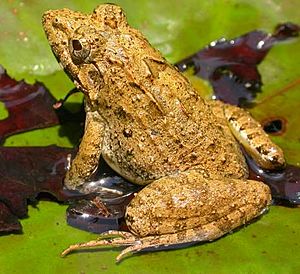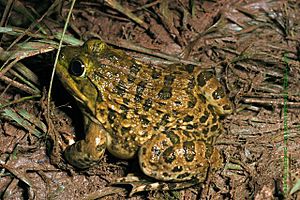Indus Valley Bullfrog facts for kids
Quick facts for kids Indus Valley Bullfrog |
|
|---|---|
 |
|
| Indian Bullfrog from the Western Ghats | |
| Scientific classification | |
| Kingdom: | |
| Phylum: | |
| Subphylum: | |
| Class: | |
| Order: | |
| Family: | |
| Genus: |
Hoplobatrachus
|
| Species: |
H. tigerinus
|
| Binomial name | |
| Hoplobatrachus tigerinus |
|
| Synonyms | |
|
Rana tigerina |
|
The Indus Valley bullfrog (also called the Indian bullfrog or Asian bullfrog) is a very large type of frog. Its scientific name is Hoplobatrachus tigerinus. You can find these frogs in countries like India, Pakistan, Bangladesh, Myanmar, Afghanistan, and Nepal. They have also been brought to Madagascar, where they are now found almost everywhere.
Contents
About the Indus Valley Bullfrog

These large frogs live in several countries across Asia. They are found in India, Bangladesh, Pakistan, Nepal, Myanmar, Afghanistan, and Sri Lanka. You can also find them on the Maldives islands and in Madagascar.
Indus Valley bullfrogs love places with fresh water. They prefer wetlands, ponds, and other watery areas. They usually stay away from coastal regions and thick forests.
Daily Life and What They Eat
The Indus Valley bullfrog is mostly a loner. It is also nocturnal, meaning it is active at night. These frogs like to hide in holes or bushes near water. They do not stay in the water all the time. Instead, they spend most of their time hiding and looking for food in the plants nearby.
These frogs eat many different things. Their diet includes various insects and other small creatures. They also hunt mice, shrews, young frogs, and even small birds. Earthworms, roundworms, and young snakes are also on their menu.
Size and Movement
The Indus Valley bullfrog can grow quite large. From its snout (nose) to its vent (tail end), it can be about 6.5 inches long. When these frogs get scared, they can jump across the surface of the water. They move on water much like they do on land.
Scientists have looked at how many of these frogs there are. The IUCN Red List says this species is of "Least Concern." This means there are still many of them around, and they are not in danger of disappearing.
Farming Indus Valley Bullfrogs
People started farming these frogs in the 1990s. This happened in Thailand. They are raised as a food source. The American bullfrog (Rana catesbeiana) is also farmed for food.
Related pages
Images for kids
-
Hoplobatrachus tigerinus (Indian bullfrog) at Kasaragod, Kerala
See also
 In Spanish: Hoplobatrachus tigerinus para niños
In Spanish: Hoplobatrachus tigerinus para niños


